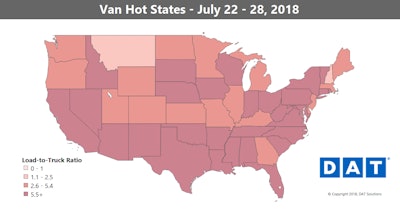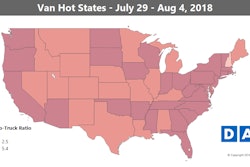Though spot market rates have fallen slightly in recent weeks, they’ve come down only from record highs set in June, in line with annual seasonal trends, according to weekly rates data from DAT. “A decline in July is typical, but prices are still sky high,” said DAT in its weekly report.
July’s per-mile van average, for instance, trended 30 percent higher than the same month last year, “accounting for both the higher price for diesel and the exceptional truckload demand we’ve seen in 2018,” says DAT’s report. Most major van markets were down in the week of July 22-28, both in terms of the load-to-truck ratio and per-mile rates.
 DAT’s map shows the load-to-truck ratio throughout the U.S., with darker shades signifying a higher load-to-truck ratio. The higher that ratio, the more upward pressure on rates, given the simply and demand imbalance. As has been typical of late, the southwest and southeastern parts of the country have a greater imbalance than other parts of the country, which now extends northward up the East Coast — the busy I-95 corridor.
DAT’s map shows the load-to-truck ratio throughout the U.S., with darker shades signifying a higher load-to-truck ratio. The higher that ratio, the more upward pressure on rates, given the simply and demand imbalance. As has been typical of late, the southwest and southeastern parts of the country have a greater imbalance than other parts of the country, which now extends northward up the East Coast — the busy I-95 corridor.Hot van markets: Rates outbound of Columbus, Ohio, ticked up in the week, particularly from Columbus to Atlanta, which added 13 cents for an average of $2.43 per mile.
Not so hot: Many high-volume lanes had lower rates last week, but some of the biggest declines were on lanes where the average price was still close to the $3-per-mile mark. For example, Chicago to Buffalo dropped 32 cents but still averaged exactly $3 per mile. Atlanta to Philadelphia fell the same amount and averaged $2.99.
—
 As noted by the map above, the load-to-truck ratio still remains heavily tilted in truckers’ favor, with the number of loads well outpacing the number of available trucks throughout the country. The darker the state, the higher the load-to-truck ratio.
As noted by the map above, the load-to-truck ratio still remains heavily tilted in truckers’ favor, with the number of loads well outpacing the number of available trucks throughout the country. The darker the state, the higher the load-to-truck ratio.Flatbed rates also retreated some from its record rates run, but, like van, “prices remain high despite the sharp drops,” DAT notes. There’s been a decline in Texas, which DAT says may be related to steel tariffs, since imported steel is used to manufacture the specialty pipes used in the oil fields.

Hot flatbed markets: There’s been a lot of volatility in flatbed pricing from week to week, but flatbed rates were down out of almost every major market in July. One exception was Las Vegas, which also had a sharp increase in rates last week. There was also a strong uptick in outbound prices from Roanoke, Va., and the average rate from there to Atlanta surged to $3.46 per mile.
Not so hot: The biggest declines were at a couple of East Coast ports — Baltimore and Savannah, Georgia. Many lanes still paid high rates despite the declines, though. For instance, the lane from Baltimore to Springfield, Mass., dropped 61 cents, but the average was still $4.57 per mile.
—
DAT’s tri-haul of the week

Charlotte to Allentown, Pa., has been a hot lane this summer, according to DAT data, but prices have fallen as of late. A van load on that lane still pays an average of $3.17 per mile, but the return trip is just $1.75. You can keep your average rate per loaded mile up closer to the $3 mark if you turn that trip into a tri-haul. Instead of going from Allentown to Charlotte, you can likely find a better-paying load going to Norfolk, Va. That lane averaged $2.86 per mile last week, and the final leg of the trip from Norfolk to Charlotte averaged $2.72. Not counting deadhead, the extra stop would add about 90 miles and push your average rate per loaded mile up from $2.46 to $2.97. If it works with your hours of service and schedule, that’s an extra $830 in revenue














